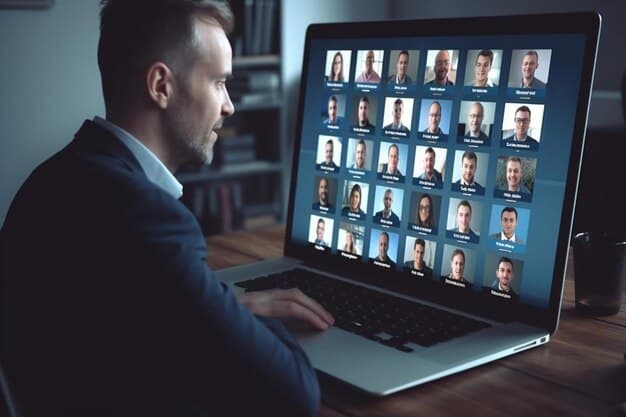Halo Effect: First Impressions in the US Workplace

The halo effect, a cognitive bias where a single positive trait influences overall perception, profoundly impacts the US workplace, shaping hiring, promotions, and interpersonal dynamics.
Ever wonder why some individuals seem to effortlessly charm their way through their careers, while others, despite equal talent, struggle to gain traction? The answer might lie in a fascinating psychological phenomenon known as the Understanding the Halo Effect: How First Impressions Shape Perceptions in the US Workplace.
The Unseen Influence: What is the Halo Effect?
The halo effect is a cognitive bias where our overall impression of a person influences how we feel and think about their character. Essentially, if we perceive someone positively in one area, that positive perception tends to “spill over” and influence our judgments in other, unrelated areas. This phenomenon is often unconscious, making it particularly potent in workplace dynamics.
This bias stems from our brain’s tendency to create shortcuts. Rather than meticulously evaluating every trait of a person, especially when time is limited, we form a quick, generalized impression. This initial impression, whether positive or negative, then acts as a filter through which all subsequent information is processed.
Historical Roots and Psychological Foundations
The term “halo effect” was coined in 1920 by psychologist Edward Thorndike, who observed it in a study involving military officers rating their subordinates. He found that a positive rating in one trait, such as intelligence, often correlated with high ratings in unrelated traits like leadership or loyalty, even without clear evidence. This early research highlighted the pervasive nature of this bias.
From a psychological standpoint, the halo effect is deeply intertwined with implicit theories of personality, where individuals hold unstated beliefs about how certain traits are linked. For example, many might implicitly associate attractiveness with intelligence or friendliness with competence. These associations, often learned through cultural exposure and personal experience, contribute significantly to the formation of halo effects.
The “What Is Beautiful Is Good” Stereotype
One of the most widely studied manifestations of the halo effect is the “what is beautiful is good” stereotype. Research consistently shows that attractive individuals are often perceived as more intelligent, persuasive, sociable, and competent, even in professional settings. This bias can unfairly advantage some individuals while disadvantaging others, irrespective of their actual abilities or qualifications.
In the US workplace, this stereotype can have tangible consequences, influencing hiring decisions, performance evaluations, and even salary negotiations. Awareness of this specific facet of the halo effect is crucial for organizations striving for fairness and meritocratic principles.
- Unconscious Bias: The effect operates largely beneath conscious awareness, making it challenging to counteract without deliberate effort.
- First Impressions: It is heavily reinforced by initial encounters, where a single positive attribute can color the entire perception.
- Cognitive Shortcut: Our brains use this bias to quickly process social information, which can lead to overgeneralizations.
Understanding the fundamental mechanisms and psychological underpinnings of the halo effect is the first step toward mitigating its potentially unfair impacts. Recognizing its presence allows for a more critical and objective evaluation of individuals in the workplace.
The halo effect, at its core, illustrates how our human tendency to create cohesive narratives about others, even based on limited information, can profoundly impact our judgments. This cognitive shortcut, while efficient for rapid social processing, can introduce significant biases when not recognized and managed.
First Impressions: The Gateway to the Halo Effect in US Workplaces
First impressions are undeniably powerful, particularly in the US workplace, where quick judgments are often made during interviews, initial meetings, or even casual encounters. These initial perceptions serve as the fertile ground upon which the halo effect can take root and flourish. A positive first impression can unlock numerous opportunities, while a negative one can create significant uphill battles.
Research indicates that within minutes, sometimes even seconds, of meeting someone, we form an initial assessment. This assessment is based on a multitude of cues: appearance, communication style, body language, and even a simple handshake. These cues, often subtle, are rapidly processed by our brains to create an overall picture of the individual.
The Interview Crucible: Where Halo Effects Are Forged
The job interview is perhaps the quintessential example of where first impressions and the halo effect play a critical role. An interviewer’s initial reaction to a candidate, spurred by factors like confidence, charisma, or even a shared alma mater, can disproportionately influence their evaluation of the candidate’s skills, qualifications, and potential fit for the role. This can lead to a candidate being judged more favorably than their credentials alone might warrant.
Conversely, a minor misstep—such as appearing nervous, or a perceived lack of eye contact—can trigger a negative halo effect, causing the interviewer to view the candidate’s subsequent answers and accomplishments through a critical lens. This dynamic underscores the importance of both interview preparedness for candidates and bias awareness for interviewers.
Networking and Social Interactions
Beyond formal interviews, the halo effect shapes perceptions in everyday workplace interactions and networking events. Someone who makes a strong, positive first impression at a company social event might be perceived as more capable in their daily tasks, even if their work performance remains unchanged. This is particularly true in cultures that value strong interpersonal skills and social adeptness.
Consider a new employee who immediately forms positive relationships with key stakeholders. Their perceived sociability might lead colleagues and managers to assume they are also highly collaborative and diligent, even before their professional output can truly prove it. This early ‘social capital’ can significantly impact their integration and future trajectory within the organization.
- Appearance: Professional attire and grooming can create an immediate positive impression.
- Non-verbal Cues: Confident posture, eye contact, and a genuine smile enhance initial perceptions.
- Communication Style: Clear, concise, and articulate speech contributes to a favorable first impression.
- Enthusiasm: Demonstrating genuine interest and energy can be highly engaging.
The compounding nature of first impressions means that early positive perceptions can create a self-fulfilling prophecy. Individuals who receive a positive halo may be given more opportunities, mentorship, and support, which in turn can actually lead to improved performance, further reinforcing the initial positive judgment. Recognizing this feedback loop is vital for fostering equitable workplaces.
In essence, the initial moments of interaction set the stage for how individuals are perceived and treated within the professional environment. Being aware of how these initial judgments are formed and influenced by the halo effect is paramount for both personal and organizational success.
Impacts on Hiring and Recruitment in the US Workplace
The halo effect casts a long shadow over the hiring and recruitment process, often influencing decisions long before a candidate even steps into an interview room. From resume reviews to final selections, this cognitive bias can inadvertently shape who gets noticed, who gets an interview, and ultimately, who gets the job, potentially undermining merit-based selection.
Hiring managers and recruiters, consciously or unconsciously, are susceptible to allowing one positive attribute of a candidate to overly influence their overall assessment. This can lead to overlooking red flags or exaggerating positives while downplaying negatives.

Resume Screening and Initial Impressions
Even at the resume screening stage, the halo effect can manifest. A candidate with a prestigious university degree or a well-known previous employer might benefit from a halo, with reviewers assuming higher competence regardless of the actual content of their work experience. Similarly, a professionally designed resume or well-formatted cover letter can create an initial positive impression that unfairly biases the perception of content.
This early bias can mean that highly qualified candidates from less conventional backgrounds or those with less polished application materials are overlooked, narrowing the talent pool and potentially leading to less diverse and less innovative teams. Organizations committed to diversity and inclusion must actively address these unconscious biases in their initial screening processes.
The Interview Process and Candidate Selection
During interviews, the halo effect becomes particularly pronounced. An interviewer might be swayed by a candidate’s articulate communication, confident demeanor, or even their physical attractiveness. These qualities, though important, can cause the interviewer to overemphasize their relevance and underestimate the importance of specific skills or technical expertise.
For example, a candidate who is exceptionally charming might be perceived as more collaborative, even without evidence from their past work. This can lead to selection based on subjective “likability” rather than objective qualifications. Structured interviews, where all candidates are asked the same questions and rated against predefined criteria, are a common strategy to mitigate this bias.
- Appearance Bias: Candidates perceived as more attractive may receive higher ratings.
- Affinity Bias: Interviewers might favor candidates who share similar backgrounds, interests, or personality traits.
- Verbal Fluency: Articulate speakers may be seen as more intelligent or competent, regardless of content.
- Past Employer Prestige: Association with a reputable company can create an undeclared positive assumption about a candidate’s abilities.
The long-term consequences of halo-driven hiring include less diverse teams, reduced innovation stemming from homogenous thinking, and a potential mismatch between employee capabilities and job requirements. These outcomes ultimately impact organizational performance and competitive advantage. Addressing the halo effect in recruitment requires deliberate strategies, including training, standardized processes, and diverse interview panels.
In sum, the halo effect poses a significant challenge to creating truly merit-based hiring systems in the US workplace. By understanding its manifestations at each stage of recruitment, organizations can implement more equitable and effective strategies.
Performance Reviews and Promotion Decisions
Once employees are in the door, the halo effect continues to play a significant, often subtle, role in their career trajectory, profoundly influencing performance reviews and promotion decisions. Managers, susceptible to this bias, might inadvertently allow one outstanding (or poor) attribute or recent achievement to disproportionately sway their overall assessment of an employee’s cumulative performance.
This can lead to situations where employees are either unfairly elevated based on one impressive project or unfairly held back due to a single perceived weakness, regardless of their broader contributions over an evaluation period.
The “Shining Star” Syndrome vs. “Consistent Performer” Oversight
The halo effect often benefits the “shining star”—the employee who delivers a highly visible, impactful project or possesses a particularly charismatic personality. This single positive aspect can create a ‘halo’ that elevates perceptions of their overall capabilities, sometimes at the expense of consistent, high-performing individuals whose contributions are less dramatic but equally vital.
Conversely, if a manager has a negative impression of an employee based on one past mistake or a perceived interpersonal issue, that ‘horn effect’ (the negative counterpart of the halo effect) can overshadow subsequent positive contributions. This makes it difficult for the employee to overcome that initial negative assessment, regardless of their improved performance.
Subjectivity in Performance Metrics
Despite efforts to create objective performance review systems, subjective elements often remain, providing fertile ground for the halo effect. Metrics that rely on manager discretion, such as “teamwork,” “attitude,” or “leadership potential,” are particularly vulnerable. A manager’s general positive feeling about an employee can inflate ratings across all such subjective categories.
This bias can also influence the feedback mechanisms. Managers might be less critical of someone they view positively, leading to less constructive feedback for development. Conversely, they might scrutinize those perceived negatively more closely, identifying more flaws even when performance is comparable.
- Recent Achievements: A spectacular recent success can overshadow a year of average performance.
- Interpersonal Skills: Being charismatic or likable can unfairly boost evaluations on collaborative tasks.
- Perceived Potential: An employee deemed to have high potential might be rated more favorably than current performance warrants.
- General Positive Attitude: A consistently upbeat disposition can lead to inflated perceptions of productivity and quality.
The long-term implications of halo-affected performance reviews include demotivation among consistent performers who feel overlooked, a lack of accurate feedback for employee development, and a potential for stagnation within teams if the right talent isn’t recognized and promoted. To counteract this, organizations are increasingly adopting multi-rater feedback (360-degree reviews) and performance calibration sessions.
Ultimately, a fair and effective performance management system requires managers to be acutely aware of their own biases. Training, structured evaluation forms, and a focus on objective, demonstrable outcomes are critical tools in mitigating the halo effect’s influence on employee progression in the US workplace.
Mitigating the Halo Effect: Strategies for Fairer Workplaces
While the halo effect is a deeply ingrained cognitive bias, its detrimental impacts on fairness and meritocracy in the US workplace are not insurmountable. Organizations and individuals can implement a range of strategies to minimize its influence, fostering more equitable hiring, performance management, and career progression.
The key lies in moving from intuitive, rapid judgments to more systematic, evidence-based evaluations, and cultivating a culture of self-awareness regarding cognitive biases.
Structured Processes and Objective Criteria
One of the most effective ways to counteract the halo effect is through the implementation of highly structured processes, particularly in hiring and performance reviews. This involves defining clear, objective criteria beforehand and applying them consistently to all candidates or employees. For example:
- Standardized Interview Questions: Asking all candidates the same set of questions ensures a consistent basis for comparison.
- Scoring Rubrics: Developing clear scoring rubrics for interviews and performance reviews helps quantify subjective assessments.
- Skill-Based Assessments: Incorporating practical tests or work samples provides objective evidence of skills, reducing reliance on perceived traits.
- Behavioral Interviewing: Asking candidates to describe past behaviors helps predict future performance more accurately than general impressions.
These structured approaches force evaluators to focus on specific, job-relevant attributes rather than being swayed by a general positive impression.

Bias Training and Awareness Programs
Simply being aware of the halo effect can significantly reduce its impact. Organizations should invest in comprehensive unconscious bias training for all employees, especially managers and those involved in hiring. These programs aim to:
They provide tools and techniques for recognizing and challenging one’s own assumptions. Understanding how the halo effect operates encourages individuals to pause and reflect before making swift judgments.
Such training should not be a one-off event but an ongoing process, reinforced through regular discussions and practical exercises. It helps to foster a culture where challenging biases is encouraged and seen as a collective responsibility.
- Recognize Bias: Help individuals identify when and how cognitive biases, including the halo effect, might be influencing their judgments.
- Challenge Assumptions: Encourage evaluators to question their initial impressions and seek out confirming or disconfirming evidence.
- Promote Self-Reflection: Foster a habit of critically evaluating one’s own decision-making processes.
These initiatives empower individuals to make more deliberate and fair decisions, rather than relying on automatic, biased responses. The goal is not to eliminate bias entirely, which is often impossible, but to manage and mitigate its effects.
While challenging, creating a workplace environment that actively seeks to mitigate the halo effect requires a multi-pronged approach: combining systemic changes with individual awareness. By doing so, organizations can move closer to true meritocracy and ensure that talent, not perception, drives success.
The Double-Edged Sword: When the Halo Effect Works in Your Favor
While much of the discussion around the halo effect centers on its potential negative consequences and the need for mitigation, it’s also important to acknowledge its more favorable side. When harnessed consciously and ethically, understanding this bias can serve as a powerful tool for individuals seeking to enhance their professional image and for organizations aiming to cultivate positive perceptions.
In essence, if certain positive attributes are consistently projected and recognized, they can indeed create a ‘halo’ that extends to other areas, potentially opening doors and fostering stronger relationships.
Cultivating a Positive Professional Image
For individuals, an awareness of the halo effect means strategically focusing on cultivating certain positive traits to enhance their overall professional image. This isn’t about being disingenuous, but rather about presenting one’s best self consistently. Key areas to focus on include:
- High-Quality Work: Consistently delivering excellent results in one area can elevate perceptions of competence across the board.
- Strong Communication Skills: Being articulate, listening actively, and communicating clearly can create a perception of intelligence and thoughtfulness.
- Professionalism and Reliability: Adhering to deadlines, being punctual, and maintaining a professional demeanor builds trust and respect.
- Positive Attitude and Collaboration: Being approachable, enthusiastic, and a good team player can foster perceptions of being easy to work with and effective.
These attributes, when consistently demonstrated, can trigger a positive halo, making colleagues and superiors more likely to attribute other positive qualities like strong leadership or problem-solving skills, even if direct evidence is less apparent.
Building Organizational Reputation and Brand
On an organizational level, the halo effect plays a significant role in building and maintaining a positive reputation and brand image. When a company excels in one highly visible area—such as innovation, customer service, or corporate social responsibility—that positive reputation can ‘halo’ over to other aspects of the business.
For example, a tech company renowned for its groundbreaking products might be perceived as a great employer, even if its internal culture isn’t perfect. Similarly, a clothing brand known for its ethical manufacturing might be seen as having higher quality products across its entire line. This demonstrates how a strong positive attribute can create a generalized positive perception among consumers, investors, and potential employees.
Companies strategically leverage this by highlighting their strengths, whether it’s their commitment to sustainability, their exceptional customer service, or their cutting-edge technology. These focus areas, when successfully communicated, contribute to a broader positive ‘halo’ for the entire organization.
It’s crucial to note that while the halo effect can work in one’s favor, it’s not a substitute for genuine competence and integrity. An initial positive perception needs to be backed up by consistent performance and ethical behavior to be sustainable. If the reality doesn’t match the projected image, the “halo” can quickly fade, leading to disillusionment and a loss of trust.
Therefore, understanding the positive applications of the halo effect means strategically identifying and consistently demonstrating core strengths, both individually and organizationally, to cultivate an overall positive perception that is both beneficial and authentic.
Beyond the Workplace: The Pervasiveness of the Halo Effect
While our focus has largely been on Understanding the Halo Effect: How First Impressions Shape Perceptions in the US Workplace, it’s important to recognize that this powerful cognitive bias extends far beyond the confines of professional life. The halo effect is a pervasive aspect of human cognition, influencing our judgments and decisions in a multitude of everyday contexts, from consumer choices to social interactions and even judicial proceedings.
Understanding its broader reach highlights just how fundamental this mental shortcut is to how we perceive the world and the people within it.
Consumer Behavior and Marketing
In the realm of consumer behavior, the halo effect is a cornerstone of effective marketing. Brands often leverage a single strong positive attribute or the endorsement of a celebrity to create an overall positive impression of a product or company. For instance:
This psychological phenomenon is what drives celebrity endorsements; the positive qualities associated with the celebrity are intended to “halo” over to the product they are promoting.
- Brand Reputation: A company with a reputation for innovation might be perceived as producing higher-quality products across its entire range.
- Product Design: An aesthetically pleasing product might be assumed to also be more functional or user-friendly.
- Ingredient Perception: If a food item is labeled “organic,” consumers might assume it’s also healthier, even if nutritional data doesn’t fully support it.
Marketers skillfully tap into this bias to shape consumer perceptions and drive purchasing decisions, demonstrating its commercial power.
Social Interactions and Relationships
In our personal lives, the halo effect constantly shapes how we perceive friends, acquaintances, and even strangers. Someone who is perceived as kind might also be assumed to be trustworthy and intelligent. Conversely, a single negative trait, such as rudeness, can trigger a ‘horn effect,’ leading us to negatively prejudge other aspects of their character.
This bias influences initial attraction, the formation of friendships, and even long-term relationships. It can lead to misjudgments, as we may fail to see flaws in those we admire or overlook strengths in those we initially dislike, perpetuating certain social dynamics.
Legal and Political Spheres
Even in critical arenas like the legal system, the halo effect can subtly influence outcomes. Studies have shown that physically attractive defendants sometimes receive more lenient sentences than less attractive defendants for similar crimes. Jurors, unconsciously swayed by a positive physical impression, might be more inclined to believe their testimony or attribute more positive character traits to them.
Similarly, in politics, a candidate’s charisma, appearance, or perceived trustworthiness (a halo) can significantly impact voter perception, sometimes overshadowing their actual policy positions or track record. This highlights the ethical implications of the halo effect when it impacts fairness and justice.
The ubiquity of the halo effect underscores the complex interplay between our cognitive processes and the social world. While it streamlines our ability to make rapid social judgments, its pervasive influence also necessitates a mindful approach to how we form opinions and make decisions, both personally and professionally.
Recognizing its presence in these diverse contexts solidifies the understanding that the halo effect is not merely a workplace phenomenon but a fundamental aspect of human perception.
| Key Aspect | Brief Description |
|---|---|
| ✨ Halo Effect Defined | A cognitive bias where one positive trait influences overall perception of a person or brand. |
| 🤝 Workplace Impact | Significantly influences hiring, performance reviews, and promotion decisions. |
| 🛡️ Mitigation Strategies | Structured processes, objective criteria, and bias training help reduce its negative effects. |
| 📈 Leveraging Positively | Consciously projecting positive traits can enhance professional image and brand reputation. |
Frequently Asked Questions About the Halo Effect
▼
The “horn effect” is the inverse of the halo effect. It’s a cognitive bias where a single negative trait or perceived flaw influences an overall negative perception of a person. For instance, if someone is perceived as rude, that single negative attribute might lead others to also view them as incompetent or dishonest, even if there’s no evidence to support those conclusions. Both effects highlight the human tendency to generalize from limited information.
▼
Completely eliminating the halo effect is challenging, as it’s a deeply ingrained cognitive bias. However, its negative impacts can be significantly mitigated. Strategies like structured interviews, objective performance metrics, diverse evaluation panels, and ongoing unconscious bias training for managers and HR professionals are crucial. The goal isn’t to erase the bias, but to increase awareness and implement systems that counteract its influence on decisions.
▼
Physical attractiveness is a well-documented trigger for the halo effect. In professional settings, attractive individuals may unconsciously be perceived as more intelligent, competent, sociable, and trustworthy. This can lead to biases in hiring, promotions, and performance evaluations, where their perceived attractiveness gives them an unfair advantage over equally or more qualified, but less attractive, counterparts. This is a significant challenge for equitable workplaces.
▼
Non-verbal cues play a critical role in fostering first impressions, which then can lead to a halo effect. Confident posture, strong eye contact, a genuine smile, a firm handshake, and appropriate gestures can all contribute to an immediate positive perception. These cues often convey characteristics like confidence, professionalism, and approachability, which can then “halo” into perceptions of competence and reliability in other areas, influencing judgments in interviews or meetings.
▼
While the halo effect is a universal cognitive bias, its specific triggers and manifestations can vary culturally. For example, in cultures that highly value humility, an overly self-promotional individual might attract a negative “horn effect” rather than a “halo.” Conversely, in cultures that value directness, perceived shyness might lead to a negative bias. Understanding these cultural nuances is important for predicting how the halo effect might operate in diverse global workplaces.
Conclusion
The halo effect, a pervasive cognitive bias, profoundly shapes how individuals are perceived and judged in the US workplace, from initial impressions during recruitment to ongoing performance evaluations and promotion decisions. Its subtle influence underscores the importance of fostering self-awareness and implementing structured, objective processes designed to mitigate its often unfair consequences. While challenging to eliminate entirely, recognizing and strategically addressing this bias is crucial for creating truly meritocratic, diverse, and equitable professional environments where talent is genuinely recognized and rewarded, rather than overshadowed by superficial perceptions.





